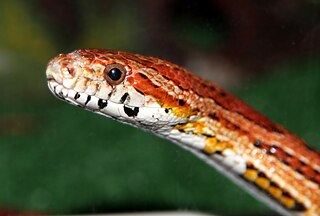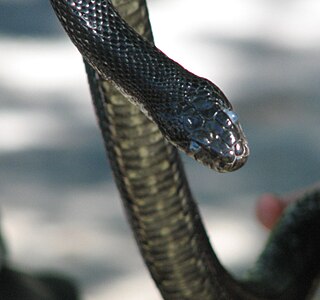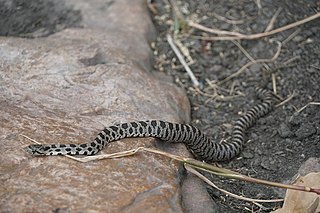
Rat snakes are members – along with kingsnakes, milk snakes, vine snakes and indigo snakes – of the subfamily Colubrinae of the family Colubridae. They are medium to large constrictors and are found throughout much of the Northern Hemisphere. They feed primarily on rodents. Many species make attractive and docile pets and one, the corn snake, is one of the most popular reptile pets in the world. As with all snakes, they can be defensive when approached too closely, handled, or restrained, but bites are not serious. Like nearly all colubrids, rat snakes pose no threat to humans. Rat snakes were long believed to be completely nonvenomous, but recent studies have shown that some Old World species do possess small amounts of venom, though the amount is negligible relative to humans.

The corn snake is a North American species of rat snake that subdues its small prey by constriction. It is found throughout the southeastern and central United States. Though superficially resembling the venomous copperhead and often killed as a result of this mistaken identity, corn snakes lack functional venom and are harmless. Corn snakes are beneficial to humans by helping to control populations of wild rodent pests that damage crops and spread disease.

Pantherophis obsoletus – also known as the western rat snake, black rat snake, pilot black snake, or simply black snake – is a nonvenomous species of Colubridae found in central North America. No subspecies are currently recognized. Its color variations include the Texas rat snake. Along with other snakes of the eastern United States, like the eastern indigo snake or the eastern racer, it is called 'black snake'.

The gray ratsnake or gray rat snake, also commonly known as the central ratsnake, chicken snake, midland ratsnake, or pilot black snake, is a species of nonvenomous snake in the genus Pantherophis in the subfamily Colubrinae. The gray ratsnake is one of about ten species within the American ratsnake genus Pantherophis.

Elaphe is a genus of snakes in the family Colubridae. Elaphe is one of the main genera of the rat snakes, which are found in many regions of the northern hemisphere. Elaphe species are medium to large constrictors by nature. Although all of the species in Elaphe are nonvenomous, bites from rat snakes are still irritably painful and can potentially cause bacterial infections, especially due to the saliva.

Pantherophis is a genus of nonvenomous colubrid snakes endemic to central and eastern regions of North America. It consists of the North American ratsnakes, the foxsnakes, and the cornsnakes. The genus, which contains 10 recognized species, first appeared in the fossil record in the Middle Miocene around 16.3 million years ago. They are a large terrestrial snake genus that lack subocular scales. Originally classified in the genus Elaphe, phylogenetic studies have found this taxon to be closely related to Pituophis. As with all snakes Pantherophis is an obligate faunivore with a diet that consists of small mammals, birds, reptiles and amphibians, and even insects. While many species conservation status is categorized as "least concern", many local populations in some species have declined where some places have them listed as federally protected. The corn snake is a popular pet reptile, due to the availability of captive-bred animals, their low maintenance and calm disposition, and the variety of color morphs. There are other species of Pantherophis that are in the pet trade, though are not as popular as the corn snake.

The foxface rabbitfish, also known as the foxface, black-face rabbitfish or common foxface, is a species of marine ray-finned fish, a rabbitfish belonging to the family Siganidae. It is found in the Indian and Pacific Oceans. It can be found in the aquarium trade.

Pantherophis vulpinus, commonly known as the foxsnake, is a species of rat snake that is endemic to North America. It is a non-venomous colubrid.

Pantherophis vulpinus, commonly known as the eastern foxsnake or eastern fox snake, is a species of rat snake in the family Colubridae. The species is nonvenomous and is endemic to the eastern Great Lakes region of the United States, as well as adjacent western Ontario in Canada. Pantherophis gloydi is sometimes considered a distinct species and sometimes considered a junior synonym of the species Pantherophis vulpinus.

The common thresher, also known as Atlantic thresher, is the largest species of thresher shark, family Alopiidae, reaching some 6 m (20 ft) in length. About half of its length consists of the elongated upper lobe of its caudal fin. With a streamlined body, short pointed snout, and modestly sized eyes, the common thresher resembles the pelagic thresher. It can be distinguished from the latter species by the white of its belly extending in a band over the bases of its pectoral fins. The common thresher is distributed worldwide in tropical and temperate waters, though it prefers cooler temperatures. It can be found both close to shore and in the open ocean, from the surface to a depth of 550 m (1,800 ft). It is seasonally migratory and spends summers at lower latitudes.

Pantherophis emoryi, commonly known as the Great Plains rat snake, is a species of nonvenomous rat snake native to the central part of the United States, from Missouri to Nebraska, to Colorado, south to Texas, and into northern Mexico.
Black rat snake may refer to:
Pilot snake may refer to:

Slowinski's rat snake is a subspecies of nonvenomous snake in the family Colubridae. The subspecies is indigenous to Louisiana, eastern Texas, and Arkansas.

Pantherophis alleghaniensis, commonly called the eastern ratsnake, is a nonvenomous colubrid species endemic to North America.

Pantherophis ramspotti, commonly known as the western fox snake, is a species of rat snake that is endemic to the upper midwestern United States, west of the Mississippi river. It is non-venomous.














